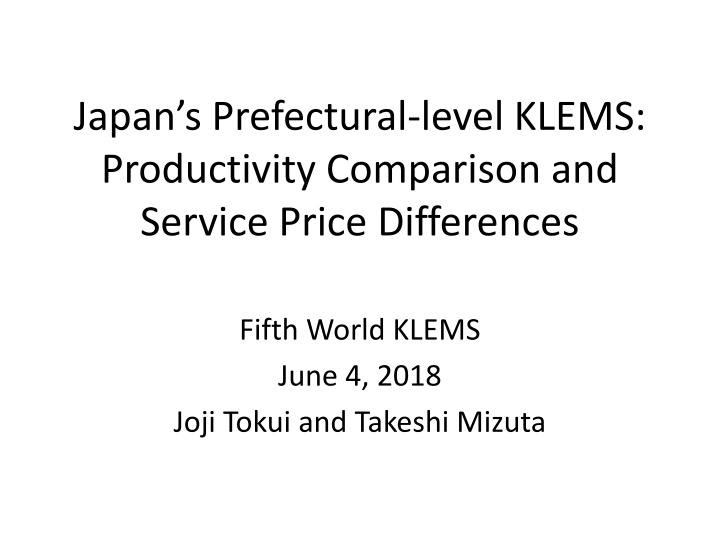
Regional-Level Japan Industrial Productivity Database Insights
Explore the Regional-Level Japan Industrial Productivity (R-JIP) database, focusing on service price differences, labor productivity decomposition, and regional labor quality data construction. Discover how R-JIP offers valuable insights for understanding productivity variations across prefectures and industries in Japan.
Download Presentation

Please find below an Image/Link to download the presentation.
The content on the website is provided AS IS for your information and personal use only. It may not be sold, licensed, or shared on other websites without obtaining consent from the author. If you encounter any issues during the download, it is possible that the publisher has removed the file from their server.
You are allowed to download the files provided on this website for personal or commercial use, subject to the condition that they are used lawfully. All files are the property of their respective owners.
The content on the website is provided AS IS for your information and personal use only. It may not be sold, licensed, or shared on other websites without obtaining consent from the author.
E N D
Presentation Transcript
Japans Prefectural-level KLEMS: Productivity Comparison and Service Price Differences Fifth World KLEMS June 4, 2018 Joji Tokui and Takeshi Mizuta
We have constructed Regional-level Japan Industrial Productivity (R-JIP) database which is consistent with JIP database. The first version is R-JIP 2012 and the latest version is R-JIP 2017. 2. You can download data from https://www.rieti.go.jp/en/database/r-jip.html 2. We are not only updating the data but also improving it. Today I will talk about one of the improvement; to take account of regional differences in service prices.
Contents 1. Brief framework of R-JIP database 2. Regional differences of service prices and their effect on TFP 3. Decomposition of regional labor productivity with newly estimated regional TFP 3. Regional Balassa-Samuelson effect
Regional-Level Japan Industrial Productivity Database (R-JIP) We compiled R-JIP database with following features. 47 prefectures in Japan 23 industries (13 manufacturing + 10 non- manufacturing) 1970-2012 (annual data) Value added, Capital Input, Labor input Input data are constructed taking their quality into account. (1)time-series quality change for both capital and labor (2)cross-sectional quality difference for labor 5
How we constructed regional labor quality data? The number of employees cross-classified by prefectures, industries, gender, age, education, and status in employment is from the Population Census (1970, 1980, 1990, 2000, 2010). Within-decennial-data are made from linear- interpolation. The construction of labor quality index among prefectures is based on the cross-sectional index number of Caves, Christensen, and Diewert (1982). 6
The difference of labor quality among prefectures in 1970 (Tokyo=1) 1.000 0.950 0.900 0.850 0.800 0.750 0.700 0.650 0.600 Osaka Gumma Ibaraki Fukui Shimane Miyazaki Aomori Kanagawa Saitama Nara Nagano Tochigi Hyogo Kagawa Akita Ishikawa Kyoto Fukuoka Shizuoka Chiba Toyama Yamanashi Saga Fukushima Aichi Yamaguchi Mie Gifu Niigata Kochi Hiroshima Nagasaki Ehime Shiga Kumamoto Wakayama Okayama Miyagi Oita Yamagata Iwate Tokyo Hokkaido Tottori Okinawa Tokushima Kagoshima 7
The difference of labor quality among prefectures in 2008 (Tokyo=1) 1.000 0.950 0.900 0.850 0.800 0.750 0.700 0.650 0.600 Osaka Ibaraki Nagano Shimane Kanagawa Gumma Fukui Nara Hyogo Saitama Tochigi Miyazaki Aomori Toyama Kagawa Ishikawa Fukuoka Gifu Fukushima Saga Nagasaki Kyoto Shiga Shizuoka Yamaguchi Okayama Chiba Wakayama Niigata Akita Tokyo Aichi Hiroshima Mie Ehime Miyagi Oita Kumamoto Kochi Iwate Kagoshima Yamanashi Okinawa Tottori Yamagata Tokushima Hokkaido 8
1. Japan is not a geographically large country, which enables prices of easily-transported goods to converge across regions. 2. But many service prices do not hold the same property because they are produced and consumed at the same time in the same place. 3. Therefore consideration of prefectural differences in service prices may matter. 4. It becomes more important because of R-JIP s detailed treatment of differences in regional labor input. 9
2. Regional differences of service prices and their effect on TFP 10
Estimation of prefectural differences in service prices To estimate prefectural differences in service prices we use the Country-Product-Dummy (CPD) Method. This method is originally devised by Rao and Timmer (2000) to construct absolute Purchasing Power Parity from international data. We apply this method to the Japanese regional data in order to estimate prefectural differences in service prices. 11
The assumption of CPD method The CPD method assumes the following relationship. where =a price of item i and prefecture r =industry s relative price of prefecture r =item i s relative price among all the items in the industry =random effect 12
Estimation equation of CPD method Taking logarithm of the , we have This leads to the following estimation equation. Dris a regional dummy, which is =1 when priis from prefecture r, and =0 when otherwise. D*iis an item dummy, which is =1 when priis item I, and =0 when otherwise. 13
We apply the CPD method to 4 categories of service industries. The estimation uses pooled data of previous 5 years. For example the estimation of 1970 uses pooled data from 1966-1970. Data source is from the annual survey by Japan s Statistics Bureau, Ministry of Internal Affairs and Communications. Number of items of each industry 1970 1980 1990 2000 2010 Construction 15 16 17 17 19 Electricity, gas and water utilities 13 15 24 28 27 Real estate 3 3 9 7 7 Transport and communications 8 8 18 35 49 Other non-government services 39 50 78 85 98 Total 78 92 146 172 200 14
In recent years, these five industries cover 40% of total nominal value added in the nation. We drop Tokyo s regional dummy and other prefectures regional dummies are measured relative to Tokyo s. The estimated coefficient of regional dummies are in logarithm and we apply inverse function to get regional relative price (relative to Tokyo=1). 15
Among five industries, the real estate industry shows the largest differences in relative price levels across regions. In the electricity, gas and water industry, as well as the transportation and communication, regional price differences show fluctuations reflecting energy price movement. In other private service industries (including non- profit private services), which have largest share among five industries, relative price levels in most of the prefectures had been lower than those in Tokyo from the beginning and price differentials relative to Tokyo have been getting even wider in recent years in many prefectures. 16
Changes in Relative Price Levels in Other Private Service Industries (including Non-profit Private Services) in Hokkaido, Tokyo = 1, 1970 through 2010 17
Calculation of absolute difference of regional TFP (1) For each prefecture r and industry i, absolute difference of regional TFP is defined by, Viris value added, Ziris real capital stock, Hiris man-hour, and QLiris labor quality of industry i and prefecture r. Upper bar indicates regional geometric average of each value. S indicates cost share of each value, and upper bar of S indicates regional average of each cost share. 18
Calculation of absolute difference of regional TFP (2) Aggregating RTFPirwith weight of each industry s value added share, we have absolute difference of regional TFP as follows. 19
Comparison of two regional TFP indexes RTFP#r=absolute difference of regional TFP taking account of regional differences of service prices RTFPr=absolute difference of regional TFP without taking account of regional differences of service prices There is following relationship between two indexes, RTFPr 23 VlogPir V+Si #= RTFPr Sir Pi i=1 20
Comparison of two regional TFP indexes: RTFP#r and RTFPr; 1970 RTFP# RTFP - RTFP# RTFP 0.5 0.4 0.3 0.2 0.1 0.0 -0.1 -0.2 -0.3 Shimane Kanagawa Osaka Nagano Ibaraki Hyogo Fukui Aomori Miyazaki Saitama Nara Ishikawa Tochigi Kagawa Toyama Gunma Fukuoka Fukushima Niigata Nagasaki Gifu Kyoto Yamagata Akita Chiba Shizuoka Okayama Shiga Tokyo Wakayama Aichi Miyagi Mie Yamaguchi Oita Kochi Hiroshima Saga Ehime Kumamoto Yamanashi Iwate Tottori Okinawa Kagoshima Hokkaido Tokushima
Comparison of two regional TFP indexes: RTFP#r and RTFPr; 2009 RTFP# RTFP - RTFP# RTFP 0.5 0.4 0.3 0.2 0.1 0.0 -0.1 -0.2 -0.3 Osaka Ibaraki Shimane Miyazaki Fukui Aomori Saitama Nagano Nara Tochigi Kanagawa Hyogo Gunma Fukuoka Kagawa Toyama Shizuoka Gifu Ishikawa Kyoto Niigata Chiba Okayama Fukushima Yamaguchi Akita Aichi Hiroshima Oita Kochi Mie Shiga Nagasaki Kumamoto Yamanashi Ehime Saga Wakayama Yamagata Iwate Miyagi Tokyo Okinawa Tokushima Hokkaido Tottori Kagoshima
Comparison of standard deviation of two regional TFP indexes; RTFP#rand RTFPr 1970 1980 1990 2000 2009 RTFP#r 0.083 0.070 0.065 0.055 0.069 RTFPr 0.089 0.074 0.080 0.069 0.079
3. Decomposition of regional labor productivity with newly estimated regional TFP (RTFP#r)
Decomposition of regional labor productivity in 1970 RTFP# capital equipment ratio labor quality labor productivity 0.5 0.4 0.3 0.2 0.1 0.0 -0.1 -0.2 -0.3 Osaka Ibaraki Fukui Aomori Miyazaki Shimane Nara Tochigi Saitama Nagano Kanagawa Hyogo Toyama Gunma Kagawa Fukuoka Shizuoka Gifu Ishikawa Chiba Yamaguchi Okayama Kyoto Akita Niigata Fukushima Mie Aichi Hiroshima Oita Kochi Shiga Ehime Saga Yamanashi Kumamoto Nagasaki Wakayama Miyagi Iwate Yamagata Tokyo Okinawa Tokushima Hokkaido Tottori Kagoshima
Decomposition of regional labor productivity in 2009 RTFP# capital equipment ratio labor quality labor productivity 0.5 0.4 0.3 0.2 0.1 0.0 -0.1 -0.2 -0.3 Osaka Ibaraki Fukui Aomori Miyazaki Shimane Nagano Tochigi Saitama Nara Fukuoka Hyogo Toyama Gunma Kanagawa Kagawa Shizuoka Ishikawa Gifu Chiba Yamaguchi Kyoto Fukushima Akita Niigata Okayama Mie Aichi Oita Hiroshima Kochi Shiga Yamanashi Saga Kumamoto Ehime Nagasaki Wakayama Miyagi Iwate Yamagata Tokyo Okinawa Hokkaido Tokushima Kagoshima Tottori
Regional version of Balassa-Samuelson effect 23 Pir Pi Vlog V+Si #=RTFPr Sir From the equation RTFPr-RTFP#ris equal to the Tornqvist index of regional price differences. Using this index we can test regional version of Balassa-Samuelson effect; whether there is a positive correlation between regional price level and regional labor productivity. RTFPr i=1
1970 .04 .02 RTFP-RTFP# 0 -.02 -.04 -.2 0 .2 .4 labor productivity 95% CI observation Fitted values
2009 .1 .05 RTFP-RTFP# 0 -.05 -.2 -.1 0 labor productivity .1 .2 .3 95% CI observation Fitted values
Correlation coefficient between regional price level and regional labor productivity 1970 1980 1990 2000 2008 2009 Correlation coef. 0.4777 0.3662 0.6104 0.3301 0.3229 0.2772 Significance level 0.0008 0.0114 0.0000 0.0235 0.0268 0.0592
Concluding Remark 1. Balassa-Samuelson effect holds in Japanese regions, and high-productivity regions go with relatively high service prices. 2. By taking account of the regional differences in service prices, we can correct overestimations of regional differences in relative TFPs. 3. But this correction is not so large as to change our conclusion that differences in relative TFPs is important in explaining recent regional labor productivity gap. 4. And differences in relative TFPs are mainly caused in such service sectors as wholesale and retail trade, and other private services.





















